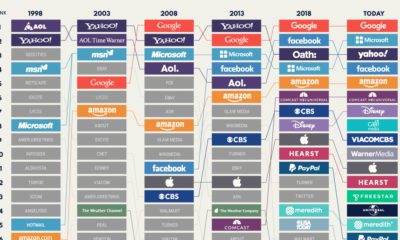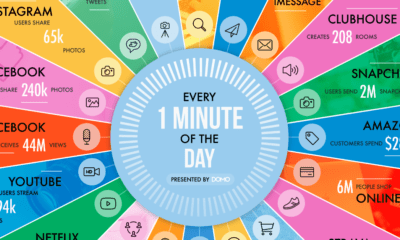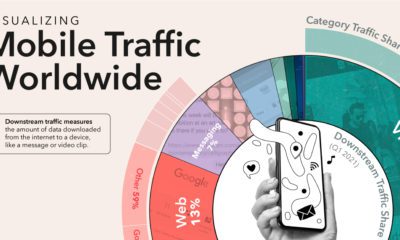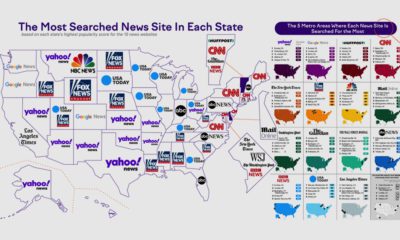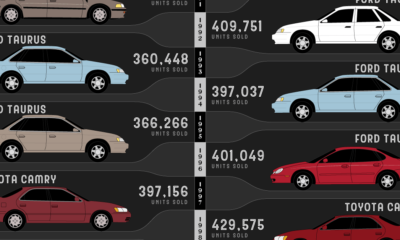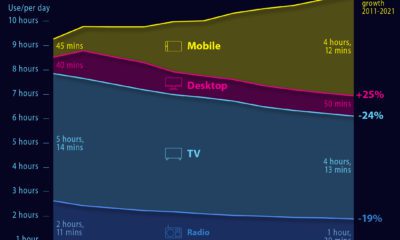Wikipedia often acts as a quick-and-dirty first source of information—and today’s intriguing animation from Data Geek shows what people are reading about the most. The video highlights more than a decade of the most popular pages on Wikipedia, sorted by total monthly views. Which topics of interest race to the top? Note to readers: Page view statistics are only for the English version of Wikipedia, which has nearly 6 million total articles to date.
A One-Stop Shop of Information
Since its 2001 inception, Wikipedia has thrived as an open collaboration project, catapulting it into the ranks of the world’s top websites today. Over the years, the upper limit of views for the most popular pages has dramatically increased. In 2008, the most popular Wikipedia page belonged to Barack Obama, during his U.S. Presidential campaign, garnering about 3 million views per month. By 2019, the page for the United States took its place at the top, this time soaring to nearly 200 million monthly views. The 12 most popular Wikipedia pages fluctuate in category, with some expected winners. Throughout the years, World War II shows up consistently in the rankings, likely propelled by research for school assignments. The U.S. is another undisputed, most-viewed page for nine years in a row (2011-2019). Following the November 2016 U.S. election, pageviews for Donald Trump also leapt into the top three. Here’s how the most popular pages shake out over a decade: Musicians also regularly top the charts, thanks to their illustrious careers and the public’s curiosity about their private lives. Michael Jackson holds a record for longest best-selling artist, but also for one of the most viewed Wikipedia pages, especially after his death in mid-2009.
A Crowdsourced Snapshot of the World
These popular Wikipedia pages provide an interesting angle on current events of the time, although it should be taken with a grain of salt. For example, the 2008 financial crisis is arguably one of the biggest events of this decade—yet it doesn’t make an appearance in these most viewed pages. One possible reason is that more reputable sources of information exist about the event, as it was widely covered in the media. Nevertheless, Wikipedia’s mission is to freely share knowledge, relying on over 250,000 monthly volunteers to keep its information accessible by anyone.
Breaking Down Barriers
Boasting over 50 million articles, it’s not hard to see why Wikipedia has reigned supreme as a crowdsourced catalog of information. However, a lesser known fact is that just one man is responsible for a significant chunk of the website’s English-language articles. In 2017, Steven Pruitt was named one of Time Magazine’s “most influential people on the Internet” for making over 3 million edits and authoring 35,000 original pages on Wikipedia—all for free. Pruitt is even helping to solve Wikipedia’s gender bias, and has expanded the share of biographical articles about women from 15% to 17.6% in a few short years. —Steven Pruitt on But fast forward to the end of last week, and SVB was shuttered by regulators after a panic-induced bank run. So, how exactly did this happen? We dig in below.
Road to a Bank Run
SVB and its customers generally thrived during the low interest rate era, but as rates rose, SVB found itself more exposed to risk than a typical bank. Even so, at the end of 2022, the bank’s balance sheet showed no cause for alarm.
As well, the bank was viewed positively in a number of places. Most Wall Street analyst ratings were overwhelmingly positive on the bank’s stock, and Forbes had just added the bank to its Financial All-Stars list. Outward signs of trouble emerged on Wednesday, March 8th, when SVB surprised investors with news that the bank needed to raise more than $2 billion to shore up its balance sheet. The reaction from prominent venture capitalists was not positive, with Coatue Management, Union Square Ventures, and Peter Thiel’s Founders Fund moving to limit exposure to the 40-year-old bank. The influence of these firms is believed to have added fuel to the fire, and a bank run ensued. Also influencing decision making was the fact that SVB had the highest percentage of uninsured domestic deposits of all big banks. These totaled nearly $152 billion, or about 97% of all deposits. By the end of the day, customers had tried to withdraw $42 billion in deposits.
What Triggered the SVB Collapse?
While the collapse of SVB took place over the course of 44 hours, its roots trace back to the early pandemic years. In 2021, U.S. venture capital-backed companies raised a record $330 billion—double the amount seen in 2020. At the time, interest rates were at rock-bottom levels to help buoy the economy. Matt Levine sums up the situation well: “When interest rates are low everywhere, a dollar in 20 years is about as good as a dollar today, so a startup whose business model is “we will lose money for a decade building artificial intelligence, and then rake in lots of money in the far future” sounds pretty good. When interest rates are higher, a dollar today is better than a dollar tomorrow, so investors want cash flows. When interest rates were low for a long time, and suddenly become high, all the money that was rushing to your customers is suddenly cut off.” Source: Pitchbook Why is this important? During this time, SVB received billions of dollars from these venture-backed clients. In one year alone, their deposits increased 100%. They took these funds and invested them in longer-term bonds. As a result, this created a dangerous trap as the company expected rates would remain low. During this time, SVB invested in bonds at the top of the market. As interest rates rose higher and bond prices declined, SVB started taking major losses on their long-term bond holdings.
Losses Fueling a Liquidity Crunch
When SVB reported its fourth quarter results in early 2023, Moody’s Investor Service, a credit rating agency took notice. In early March, it said that SVB was at high risk for a downgrade due to its significant unrealized losses. In response, SVB looked to sell $2 billion of its investments at a loss to help boost liquidity for its struggling balance sheet. Soon, more hedge funds and venture investors realized SVB could be on thin ice. Depositors withdrew funds in droves, spurring a liquidity squeeze and prompting California regulators and the FDIC to step in and shut down the bank.
What Happens Now?
While much of SVB’s activity was focused on the tech sector, the bank’s shocking collapse has rattled a financial sector that is already on edge.
The four biggest U.S. banks lost a combined $52 billion the day before the SVB collapse. On Friday, other banking stocks saw double-digit drops, including Signature Bank (-23%), First Republic (-15%), and Silvergate Capital (-11%).
Source: Morningstar Direct. *Represents March 9 data, trading halted on March 10.
When the dust settles, it’s hard to predict the ripple effects that will emerge from this dramatic event. For investors, the Secretary of the Treasury Janet Yellen announced confidence in the banking system remaining resilient, noting that regulators have the proper tools in response to the issue.
But others have seen trouble brewing as far back as 2020 (or earlier) when commercial banking assets were skyrocketing and banks were buying bonds when rates were low.
